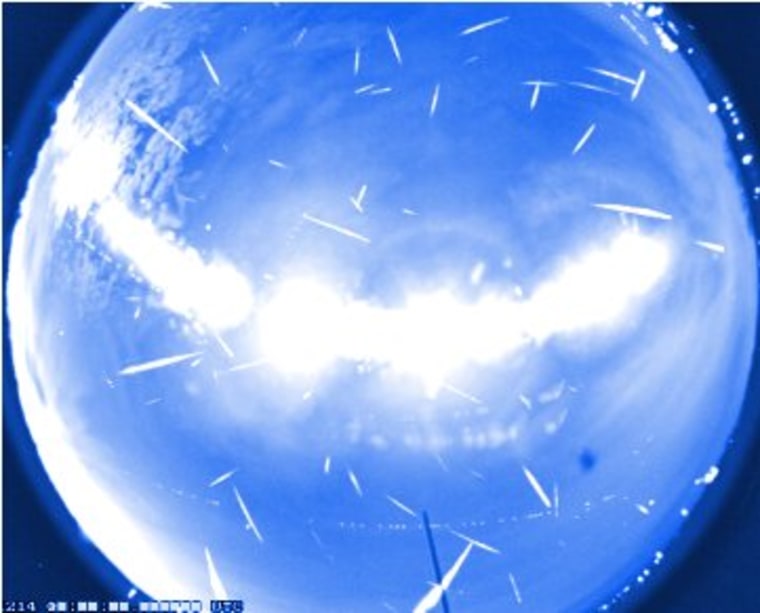The upcoming Geminid meteor shower next week may promise to be the best sky show of the year, but for many scientists it's a space light show shrouded in mystery.
Skywatchers should catch a nice view of the beguiling phenomenon between local midnight and sunrise on Tuesday, Dec. 14.
Most meteor showers come from comets, which spew ample meteoroids for a night of shooting stars. The Geminids are different. Their source is not a comet but a strange rocky object named 3200 Phaethon that sheds very little dusty debris not nearly enough to explain the Geminids.
"The Geminids are my favorite, because they defy explanation," said NASA astronomer Bill Cooke, a meteor expert at the agency's Marshall Space Flight Center in Huntsville, Ala.
This sky map shows where to look to see the Geminid meteor shower when the peak on Dec. 13 and Dec. 14.
Geminids meteor mystery
Meteor showers are created when the Earth passes through a stream of small space rocks, which then burn up as they pass through the atmosphere, creating so-called " shooting stars." But astronomers still don't know where all the rocky material for the Geminid shower comes from.
"Of all the debris streams Earth passes through every year, the Geminids' is by far the most massive," Cooke said in a statement. "When we add up the amount of dust in the Geminid stream, it outweighs other streams by factors of 5 to 500."
This makes the Geminids the gorilla of meteor showers. Yet 3200 Phaethon is more of a weakling.
3200 Phaethon was discovered in 1983 by NASA's IRAS satellite and promptly classified as an asteroid.
After all, scientists thought, what else could the space object be? It did not have a tail, its orbit intersected the main asteroid belt and its colors strongly resembled that of other asteroids. In fact, 3200 Phaethon resembles main belt asteroid Pallas so much, it might be a small chip off that massive block, NASA officials said.
"If 3200 Phaethon broke apart from asteroid Pallas, as some researchers believe, then Geminid meteoroids might be debris from the breakup," Cooke said. "But that doesn't agree with other things we know."
Those "other things" includes the orbits of the Geminid meteoroids, which suggest they were ejected from 3200 Phaethon when the object was close to the sunnot when it was out in the asteroid belt in a cosmic break-up with Pallas.
The term meteoroid refers to space rocks that have not yet entered Earth's atmosphere to become a blazing fireball, or meteor. If any of these objects reach the ground, they are called meteorites.
Some scientists, on the other hand, think that the debris feeding the Geminids is created when 3200 Phaethon swings in near the sun and receives a blast of solar heating that might boil jets of dust into the Geminid stream.
To test the hypothesis, researchers turned to NASA's twin STEREO spacecraft, which are designed to study solar activity. Coronagraphs onboard STEREO can detect sungrazing asteroids and comets, and in June 2009 they detected 3200 Phaethon only 15 solar diameters from the sun's surface.
The answer may surprise you
What happened next surprised David Jewitt and Jing Li, planetary scientists at the University of California at Los Angeles who analyzed the data.
"3200 Phaethon unexpectedly brightened by a factor of two," they wrote. "The most likely explanation is that Phaethon ejected dust, perhaps in response to a break-down of surface rocks (through thermal fracture and decomposition cracking of hydrated minerals) in the intense heat of the sun."
Jewett and Li's hypothesis is compelling, but they point out a problem: The amount of dust 3200 Phaethon ejected during its 2009 sun encounter added a mere 0.01 percent to the mass of the Geminid debris stream not nearly enough to keep the stream replenished over time. Perhaps the rock comet was more active in the past?
"We just don't know," Cooke said. "Every new thing we learn about the Geminids seems to deepen the mystery."
This month when Earth passes through the Geminid debris stream it will produce as many as 120 meteors per hour over dark-sky sites.
Bundle up, go outside and savor the mystery.
